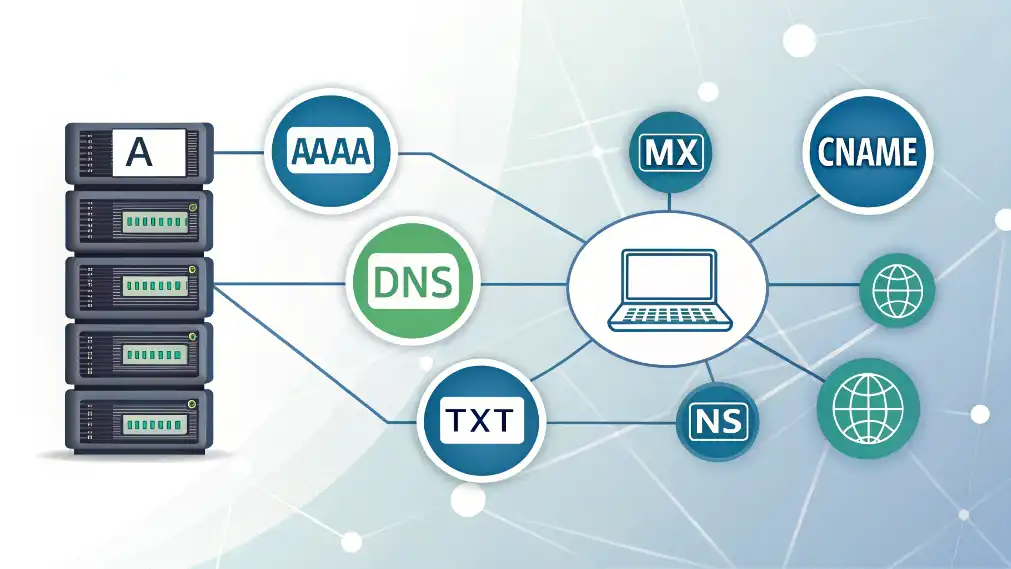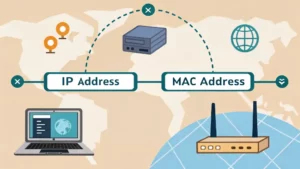Table of Contents
What Are the Different DNS Record Types (And How They Work)
DNS record types define how your website connects to the internet. From pointing domains to IPs to verifying ownership, each type plays a vital role. There are over 50 DNS record types, but mastering just nine can empower you to solve real-world DNS issues gracefully.
What Are DNS Record Types?
DNS (Domain Name System) record types are instructions stored in DNS zone files. They tell DNS resolvers how to handle incoming requests for specific domains. These records are stored on authoritative DNS servers, and they’re crucial for domain resolutions, email delivery, and service availability.
What Are the 4 Main Types of DNS Records?
While there are dozens of DNS record types, these four are foundational:
- A Record – Maps a domain to an IPv4 address.
- AAAA Record – Maps a domain to an IPv6 address.
- NS Record – Designates the authoritative nameserver for a domain.
- CNAME Record – Aliases one domain to another.
What Are the 8 DNS Records You Should Know?
If you’re managing a domain, these 8 DNS records are essential:
| Record Type | Purpose | Example |
|---|---|---|
| A | Maps domain to an IPv4 address | example.com → 192.0.2.1 |
| AAAA | Maps domain to an IPv6 address | example.com → 2001:db8::1 |
| CNAME | Aliases a domain to another domain | www → example.com |
| NS | Specifies the authoritative DNS servers | example.com NS → ns1.host.com |
| MX | Directs email to mail servers | example.com MX → mail.example.com |
| TXT | Stores human-readable text, often for verification | v=spf1 include:example.com |
| SOA | Contains DNS zone settings & metadata | Start of Authority data |
| SRV | Defines location of services | _sip._tcp.example.com |
How Many A Records Can You Have per Domain?
There’s no strict limit imposed by DNS specifications—you can have multiple A records pointing to the same or different IPs. This setup, often used for load balancing or geo-redundancy, allows your domain to resolve based on server availability or proximity.
An A Record Contains What Information?
An A record links a domain name to an IPv4 address. It includes:
- Hostname (e.g., mysite.com)
- IPv4 Address (e.g., 192.0.2.44)
- TTL (Time to Live)
The DNS A record is fundamental for directing traffic to your web server.
A Record vs NS Record – What’s the Difference?
A Record maps a domain name to an IP address for resolving web traffic. On the other hand, an NS Record points to the server that’s authoritative for the domain’s DNS records.
In simple terms:
- A Record: “This site lives at this IP.”
- NS Record: “Ask this DNS server for the IP.”
Where Are DNS Records Stored?
DNS records are stored in DNS zone files hosted on authoritative name servers. These servers provide the official resource data for a domain and respond to DNS queries across the internet.
Your DNS provider—like Cloudflare, GoDaddy, or AWS Route 53—manages these records via a DNS control panel.
What Is an AAAA Monitor?
An AAAA monitor is a system or script that continuously checks the status of IPv6-based endpoints. It ensures the AAAA record (IPv6) is resolving correctly, and the destination server is responsive. This is common in modern server stacks where IPv6 support is critical.
How to Check DNS Record Type?
You can use tools like MXToolbox, DNS Checker, or run a command from the terminal:
dig A example.com nslookup -type=MX example.com
These commands return the specified record type data straight from the DNS server.
Why Understanding DNS Record Types Matters
Managing DNS effectively impacts your website’s:
- Availability – Correct A or AAAA records ensure customers can reach your site.
- Email Reception – MX and TXT records determine if you receive emails.
- Brand Protection – Proper DNS hygiene helps prevent spoofing or misuse.
In short, DNS isn’t only for IT admins—it’s a digital foundation every website owner must understand.
Frequently Asked Questions (DNS FAQ)
- What is the DNS zone?
It’s a segment of the DNS namespace managed by a specific organization or administrator. It defines all DNS records for a domain. - Can a domain have multiple A records?
Yes. Multiple A records can point to different IPs for redundancy and speed optimization. - What happens if you don’t define an NS record?
Your domain will not resolve since there’s no indication of where its DNS configurations are located. - How do I know if my A record is set correctly?
Use DNS lookup tools or command-line utilities likedigornslookupto confirm. - Do AAAA records replace A records?
Not necessarily; they complement each other. IPv6 (AAAA) is the future, but many systems still rely on IPv4.




